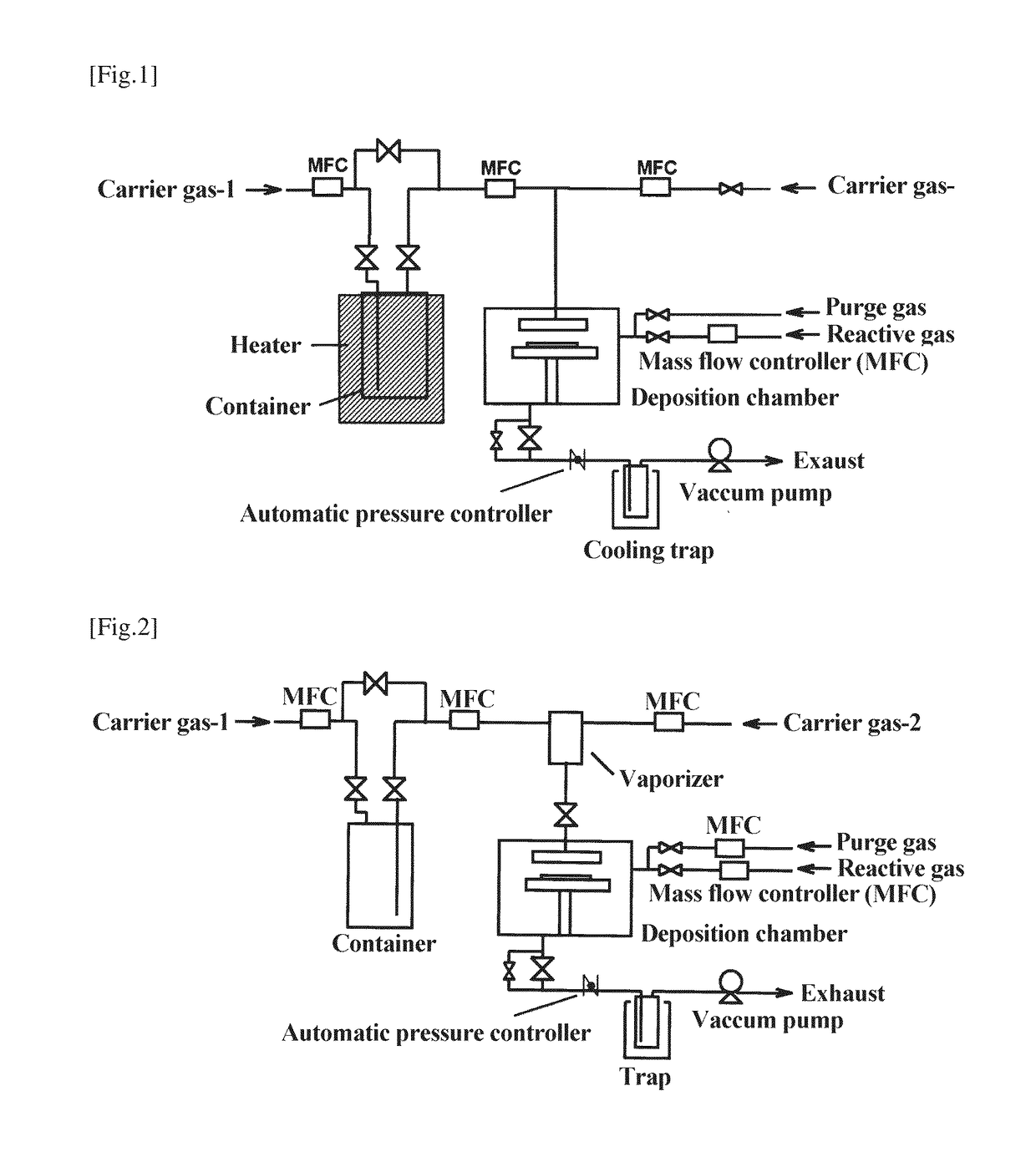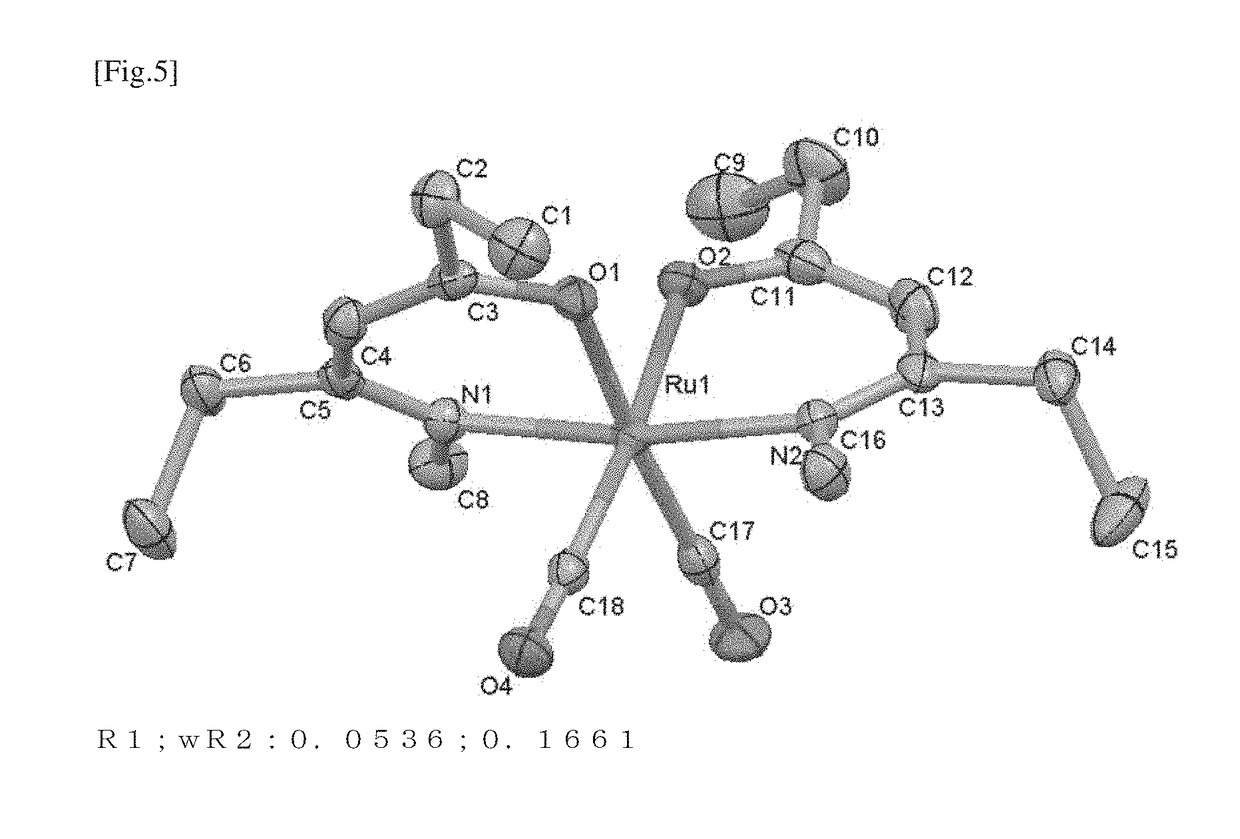Ruthenium compound, material for thin film formation, and process for thin film formation
a technology of ruthenium compound and thin film, applied in the field of ruthenium compound, material process for thin film formation, can solve the problem that the ruthenium compound of patent literature 1 is not sufficiently satisfactory as a material, and achieves the effects of good reactivity, sufficient volatility, and low melting poin
- Summary
- Abstract
- Description
- Claims
- Application Information
AI Technical Summary
Benefits of technology
Problems solved by technology
Method used
Image
Examples
examples
[0067]The present invention will now be illustrated in greater detail with reference to Examples and Evaluation Examples, but it should be understood that the invention is not construed as being limited thereto.
Example 3—Preparation of Compound No. 3
[0068]In an argon atmosphere, 2.0 g (3.13 mmol) of Ru3(CO)12, 100 ml of decane, and 2.9 g (20.5 mmol) of 5-methylamino-4-hepten-3-one were mixed and stirred at a water bath temperature of 130° C. under atmospheric pressure for 31.5 hours. After allowing the mixture to cool to room temperature, the mixture was filtered using a G2 ball filter to obtain a yellow filtrate. The filtrate was evaporated at a bath temperature of 110° C. under reduced pressure to remove decane to give an orange liquid, which was distilled at 130° C. under reduced pressure using a glass tube oven to furnish 1.7 g (yield: 44%) of compound No. 3 as a yellow solid (melting point: 54° C.). The product was analyzed by (1) ambient-pressure TG-DTA, (2)1H-NMR, and (3) DSC...
example 2
on of Compound No. 4
[0070]In an argon atmosphere, 1.36 g (2.13 mmol) of Ru3(CO)12, 75 ml of decane, and 2.08 g (13.4 mmol) of 5-ethylamino-4-hepten-3-one were mixed and stirred at a water bath temperature of 128° C. under atmospheric pressure for 21.5 hours. After allowing the mixture to cool to room temperature, the mixture was filtered using a G2 ball filter to obtain an orange filtrate. The filtrate was evaporated at a bath temperature of 118° C. under reduced pressure to remove decane to give an orange liquid, which was distilled at 125° C. under reduced pressure using a glass tube oven to afford 0.85 g (yield: 28%) of compound No. 4 as an orange liquid. The product was analyzed by (1) ambient-pressure TG-DTA, (2)1H-NMR, and (3) DSC. The results are described below.
Analytical Values:
(1) Ambient-Pressure TG-DTA
[0071]Fifty percent mass loss temperature: 245° C. (Ar flow rate: 100 ml / min; rate of temperature rise: 10° C. / min)
(2)1H-NMR (Solvent: Deuterobenzene) (Chemical Shift:Multi...
example 3
on of Compound No. 8
[0073]In an argon atmosphere, 2.04 g (3.18 mmol) of Ru3(CO)12, 115 ml of decane, and 3.68 g (20.1 mmol) of 5-ethylamino-2,6-dimethyl-4-hepten-3-one were mixed and stirred in at a bath temperature of 140° C. under atmospheric pressure for 24 hours. After allowing the mixture to cool to room temperature, the mixture was filtered using a G2 ball filter to obtain a yellow filtrate. The filtrate was evaporated at a bath temperature of 77° C. under reduced pressure to remove decane to give an orange liquid, which was distilled at 125° C. under reduced pressure using a glass tube oven to afford 1.1 g (yield: 22%) of compound No. 8 as a transparent viscous yellow liquid. The product was analyzed by (1) ambient-pressure TG-DTA, (2) reduced-pressure TG-DTA, (3)1H-NMR, and (4) DSC. The results are described below.
Analytical Values:
(1) Ambient-pressure TG-DTA
[0074]Fifty percent mass loss temperature: 240° C. (Ar flow rate: 100 ml / min; rate of temperature rise: 10° C. / min)
(2)...
PUM
 Login to View More
Login to View More Abstract
Description
Claims
Application Information
 Login to View More
Login to View More - R&D
- Intellectual Property
- Life Sciences
- Materials
- Tech Scout
- Unparalleled Data Quality
- Higher Quality Content
- 60% Fewer Hallucinations
Browse by: Latest US Patents, China's latest patents, Technical Efficacy Thesaurus, Application Domain, Technology Topic, Popular Technical Reports.
© 2025 PatSnap. All rights reserved.Legal|Privacy policy|Modern Slavery Act Transparency Statement|Sitemap|About US| Contact US: help@patsnap.com



